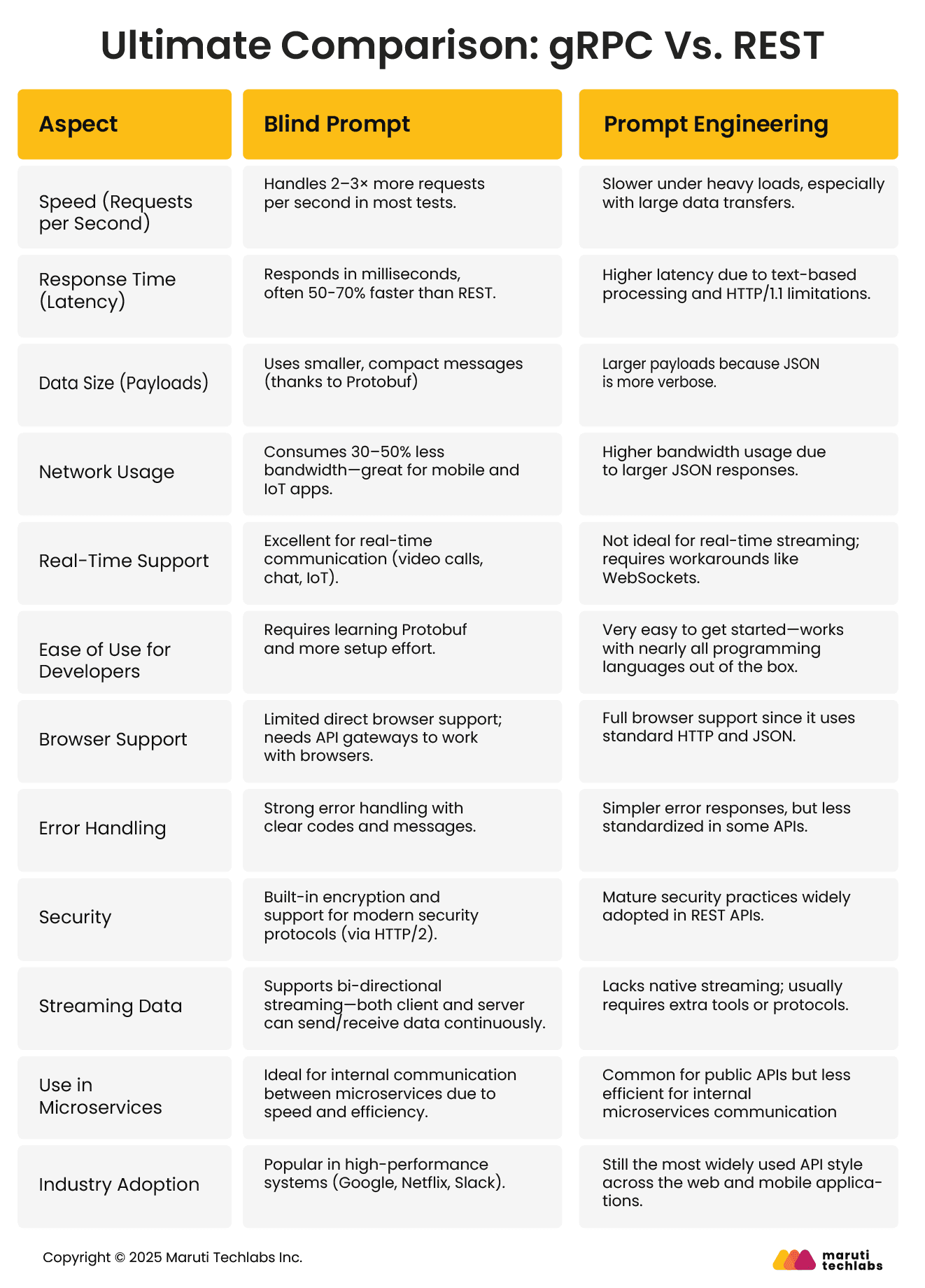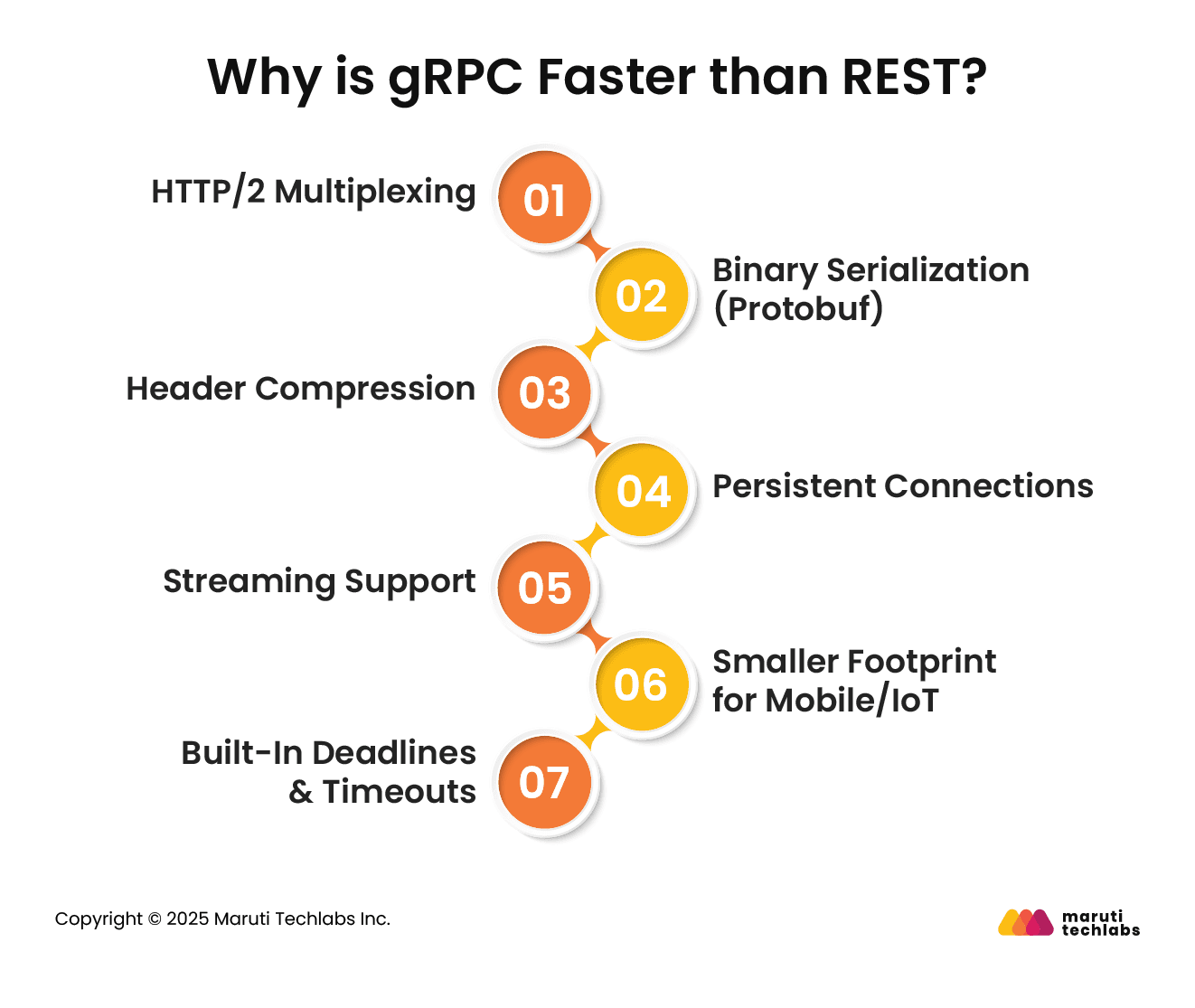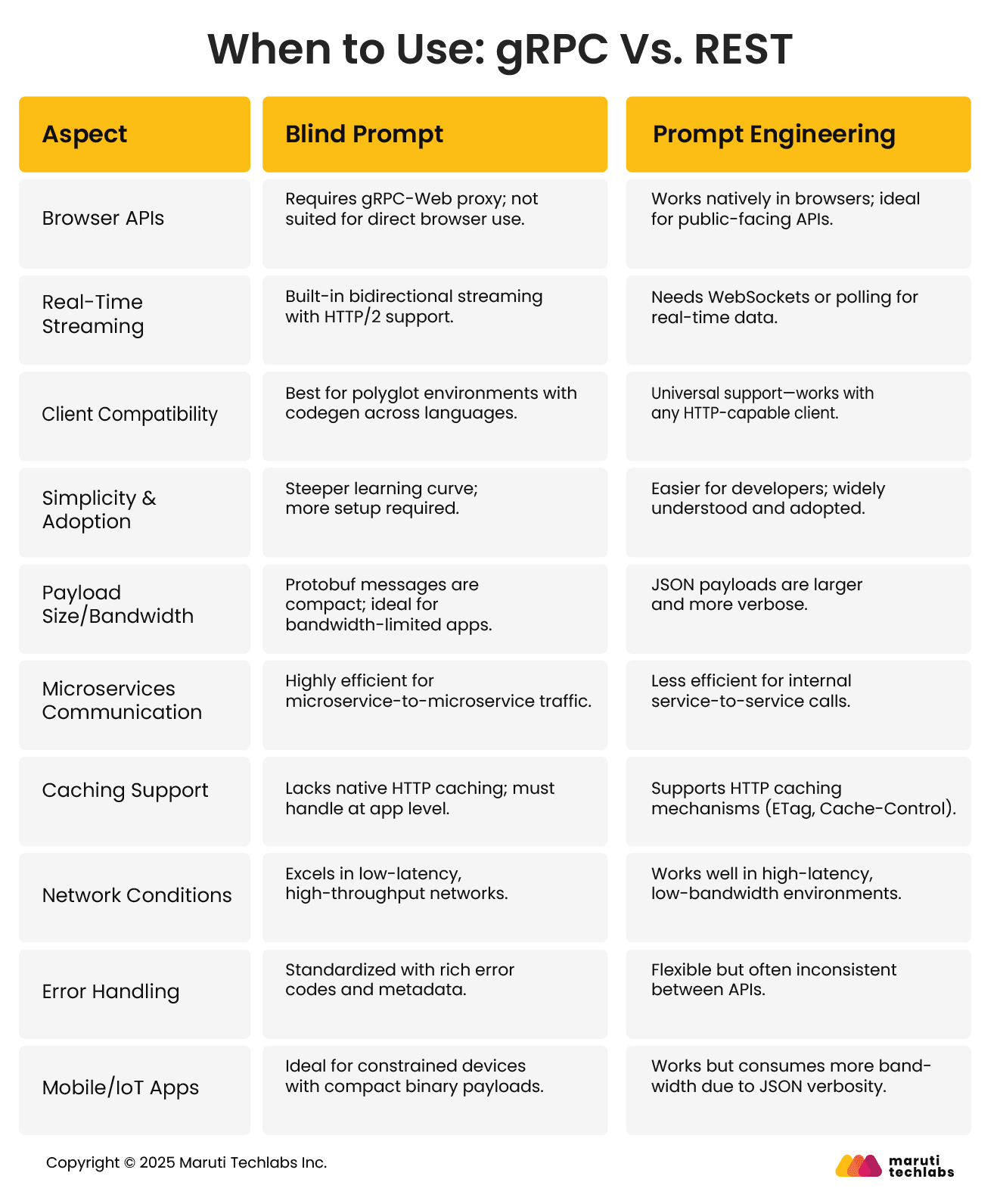

REST vs gRPC: Which is Better for Your Application?






In today’s fast-paced microservices era, the choice of API protocol can significantly impact your application's performance, scalability, and overall developer experience. gRPC, with its sleek use of HTTP/2 and Protocol Buffers, is often cited as significantly faster and lighter than traditional REST approaches.
A recent academic-grade benchmark demonstrated that gRPC can handle up to ~8,700 requests/sec, nearly 2.5 times the throughput of a JSON/HTTP REST setup.
Still, REST isn’t out of the game. Its simplicity, universal compatibility, and vast ecosystem continue to make it the go-to choice for public APIs, mobile/browser clients, and projects where developer familiarity trumps raw speed.
In this article, we offer a comparison of different benchmarks between gRPC and REST. In addition, we answer the burning question: why gRPC is better than REST, and when to use gRPC Vs. REST.
Whether you’re optimizing an internal microservices mesh, deploying user‑facing APIs, or weighing development costs versus runtime gains, this post will help you pinpoint which protocol aligns best with your project goals.
Before comparing gRPC vs REST, let us first understand the basics of APIs(Application programming interfaces). APIs are the set of rules and definitions that enable the applications to interact with each other. API defines the methods and types of calls and requests one application can make to another and formats those data and recommendations.

APIs support the “pluggability” of applications that create a more extensive system. They allow two applications to communicate even though they are written in different programming languages and running on other platforms.
A REST (Representational State Transfer) API is an architectural style for designing web services that communicate over standard HTTP(S), using resource-based URLs and verbs like GET, POST, PUT, and DELETE.
REST emphasizes stateless operations, client–server separation, cacheability, and a uniform interface. These principles ensure scalability, simplicity, and broad compatibility.
Its prevalence makes it ideal for modern use cases like connecting web and mobile apps to backends, integrating third-party services (e.g., payment gateways or social media APIs), managing cloud resources via API, and controlling IoT devices, all typically exchanging JSON over HTTP.
gRPC is a high-performance, open-source RPC (Remote Procedure Call) framework that Google created to facilitate high-speed communication between microservices.
It uses HTTP/2 for transport and Protocol Buffers (Protobuf) for compact, binary message serialization, enabling fast, low-latency, and bandwidth-efficient communication.
gRPC supports four service types, including unary and bidirectional streaming, making it ideal for use cases such as microservice interactions, real-time data streaming, mobile-to-backend communication, IoT telemetry, and polyglot environments.
It also offers strong typing, code generation, built-in deadlines/timeouts, and support for streaming, which suits performance-critical and distributed system architectures.
Feature | gRPC | REST | |||
|
|
| |||
| Response Time (Latency) | Responds in milliseconds , often 50-70% faster than REST. | Higher latency due to text-based processing and HTTP/1.1 limitations. | |||
| Data Size (Payloads) | Uses smaller, compact messages (thanks to Protobuf) | Larger payloads because JSON is more verbose. | |||
| Network Usage | Consumes 30–50% less bandwidth—great for mobile and IoT apps. | Higher bandwidth usage due to larger JSON responses. | |||
| Real-Time Support | Excellent for real-time communication (video calls, chat, IoT). | Not ideal for real-time streaming; requires workarounds like WebSockets. | |||
| Ease of Use for Developers | Requires learning Protobuf and more setup effort. | Very easy to get started—works with nearly all programming languages out of the box. | |||
| Browser Support | Limited direct browser support; needs API gateways to work with browsers. | Full browser support since it uses standard HTTP and JSON. | |||
| Error Handling | Strong error handling with clear codes and messages. | Simpler error responses, but less standardized in some APIs. | |||
| Security | Built-in encryption and support for modern security protocols (via HTTP/2). | Mature security practices widely adopted in REST APIs. | |||
| Streaming Data | Supports bi-directional streaming—both client and server can send/receive data continuously. | Lacks native streaming; usually requires extra tools or protocols. | |||
| Use in Microservices | Ideal for internal communication between microservices due to speed and efficiency. | Common for public APIs but less efficient for internal microservices communication. | |||
| Industry Adoption |
| Still the most widely used API style across the web and mobile applications. |

You can use gRPC as a cross-language if you have written a web service in Golang, which makes it very scalable. gRPC uses a protocol buffer for data serialization, making the payloads faster, smaller, and more straightforward. Therefore, gRPC uses an HTTP 2 to support high-scale performance and uses binary data instead of text to make communication more compact and efficient.
Comparing REST vs gRPC, it is possible to turn off the message compression using the gRPC. You can also send an already compressed image instead of compressing it again, which takes up more time. gRPC is also type-safe. For instance, you cannot consider a banana if it is expecting an apple. Similarly, if the server expects an integer, gRPC won’t allow string because these two are different types.
If we talk about REST API, it is a cross-language that makes web services flexible and scalable. It is the most commonly used web service. Communication in REST often happens using JSON, which is a human-readable language. Therefore, it is easy for developers to determine if the client input is sent correctly to the server and back.
The most crucial advantage of REST API is that it does not need to set up a client. You just have to make calls to the server address, unlike gRPC, which requires the client setup.
REST API still holds importance when the payload is small, and several clients simultaneously make a server call. As a result, gRPC is a lot faster than REST API in most cases. When you create a web service that requires many client calls simultaneously and uses small payloads as input and output, REST might be the better choice.
Beyond speed, gRPC and REST differ in developer experience, compatibility, and real-world flexibility. Here’s how these differences impact your API strategy:
gRPC supports over 10 languages (Java, Go, Python, C#, etc.) with automatic client and server code generation using Protobuf. REST is language-agnostic but doesn’t offer code generation—developers build clients manually for HTTP/JSON APIs.
gRPC natively enables client, server, and bidirectional streaming over a single connection. REST lacks native streaming; developers often resort to long polling or WebSockets, which adds complexity.
REST works directly in browsers since it relies on HTTP/1.1 and JSON. gRPC, built on HTTP/2 and Protobuf, needs a proxy (like gRPC-Web) for browser compatibility, which can limit its use in web APIs.
REST works well with HTTP caching via standard headers (ETag, Cache-Control). gRPC doesn’t support HTTP caching out of the box, so developers need to implement caching at the application layer.
gRPC uses a consistent, well-defined error model with status codes and rich error details. REST errors are less standardized—many APIs implement custom error responses, which can lead to inconsistencies.
Modern distributed systems demand high efficiency, low latency, and scalable communication. gRPC outpaces REST by leveraging advanced protocols and data formats that optimize network usage and speed up client-server interactions.
Here’s how:

gRPC uses HTTP/2, enabling multiple requests and responses to share a single connection. This eliminates “head-of-line blocking” common in REST’s HTTP/1.1 and allows gRPC to handle 2x–3x more concurrent requests.
Protobuf, gRPC’s serialization format, creates compact binary payloads. These are 5–10x smaller than JSON, resulting in faster encoding/decoding and less network bandwidth consumption.
With HTTP/2’s HPACK header compression, gRPC reduces repetitive metadata, saving bandwidth. REST’s uncompressed headers can bloat API calls, increasing latency by 10–20% in high-volume traffic.
gRPC keeps TCP connections alive across requests, avoiding the overhead of opening/closing connections. This is critical for high-throughput systems where REST’s frequent handshakes slow performance.
Unlike REST’s single-request model, gRPC supports bidirectional streaming, enabling continuous data flow. This makes it ideal for real-time apps like live dashboards or video calls where REST needs additional workarounds.
Protobuf’s small message sizes and efficient parsing make gRPC a better fit for bandwidth-constrained environments like IoT devices and mobile apps, where REST’s larger JSON payloads consume more data.
gRPC allows clients to set deadlines for API calls, which helps avoid stalled connections. REST requires additional implementation for such controls, which can increase complexity and response times.
Aspect | Use gRPC | Use Rest | |
| Browser APIs | Requires gRPC-Web proxy; not suited for direct browser use. |
| |
| Real-Time Streaming | Built-in bidirectional streaming with HTTP/2 support. | Needs WebSockets or polling for real-time data. | |
| Client Compatibility | Best for polyglot environments with codegen across languages. |
| |
| Simplicity & Adoption | Steeper learning curve; more setup required. |
| |
| Payload Size/Bandwidth | Protobuf messages are compact; ideal for bandwidth-limited apps. | JSON payloads are larger and more verbose. | |
| Microservices Communication | Highly efficient for microservice-to-microservice traffic. |
| |
| Caching Support | Lacks native HTTP caching; must handle at app level. | Supports HTTP caching mechanisms (ETag, Cache-Control). | |
| Network Conditions | Excels in low-latency, high-throughput networks. |
| |
| Error Handling | Standardized with rich error codes and metadata. |
| |
| Mobile/IoT Apps | Ideal for constrained devices with compact binary payloads. |
|

API is an entity-oriented style that standardizes your procedures’ names and imposes other naming conventions. Using cloud-native solutions, gRPC shines with products like cloud endpoints because it doesn't force your clients to accept gRPC technologies just because you adopted them. Also, when the API is internal, gRPC plays a prominent role by controlling the technology choices of all your clients and servers.
REST APIs are widely supported because every virtual microservices-based architecture entirely depends on them, acting as a glue. However, looking at all the features, gRPC APIs seem to be the “future.”
APIs enable faster innovation with evolving technologies, building better products and helping you stand out. Additionally, while implementing the API architecture, ensure it can handle end-to-end service migrations and development.
At Maruti Techlabs, we have successfully migrated functional applications from monolithic to microservices architecture. Our DevOps and cloud application development experts factor in the complexity of your application and plan the migration by doing a quick PoC.
Through our services, we have created robust applications that facilitate the deployment of new features, traffic routing, rollouts (without downtime), and selective scaling of software components.
If you want to modernize your application, simply email us at hello@marutitect.com, and we’ll take it from there.
Curious about the potential costs involved in modernizing or migrating your architecture? Try our Cloud Migration Cost Calculator to get a quick estimate and plan your next steps confidently.
On most occasions gRPC outperforms REST in terms of latency and throughput due to binary protocol and efficient serialization.
gRPC with its binary serialization and HTTP/2 support can significantly outperform REST in areas that require low latency, high throughput, real-time communication, or while handling complex data structures.
gRPC utilizes a binary format that is compact and efficient known as Protocol Buffers (protobuffs) to handly payloads. REST generally uses JSON or XML, that are text-based and less efficient for serialization and deserialization.
Yes, you can leverage the best of both gRPC and REST to suit your project’s requirements. This hybrid approach allows you to use gRPC for high-performance microservices, and REST for other areas.
REST is crafted on principles of CRUD operations and resource-oriented architecture that relies on standard HTTP methods (GET, POST, PUT, DELETE) and generally uses JSON or XML to exchange data.
On the other hand, gRPC is created using remote procedure call (RPC) framework that allows bi-directional streaming, and uses Protocol Buffers for efficient serialization, and HTTP/2 for transport.
REST APIs follow standard HTTP methods for implementation like GET, POST, PUT, DELETE and uses a resource-oriented approach where each endpoint represents a resource.
gRPC are implemented using protocol buffers and HTTP/2 for transport which leads to a bit complex but highly efficient implementations.
gRPC uses an efficient binary serialization format, protocol buffers, and HTTP/2 that allows multiplexing and compressing, reducing latency and increasing throughput, when compared to REST’s JSON/XML and HTTP/1.1 respectively.


